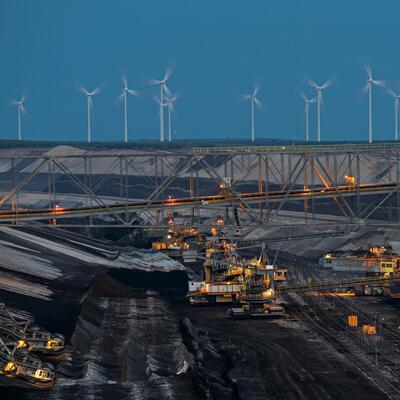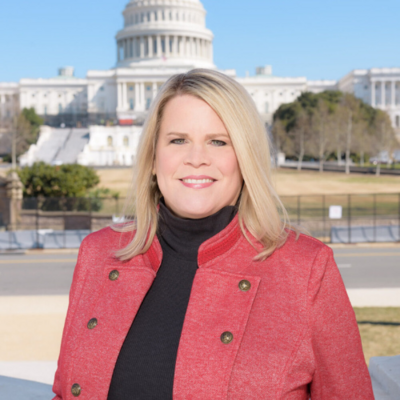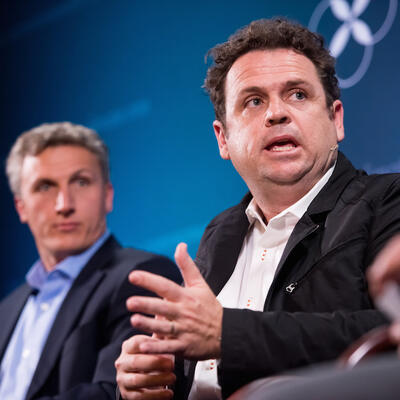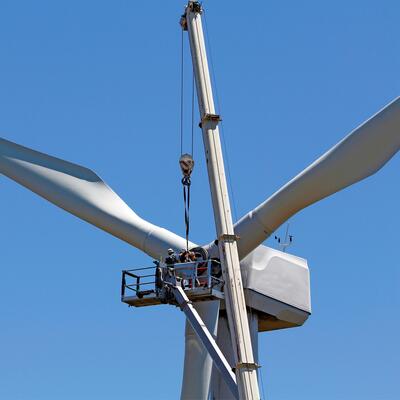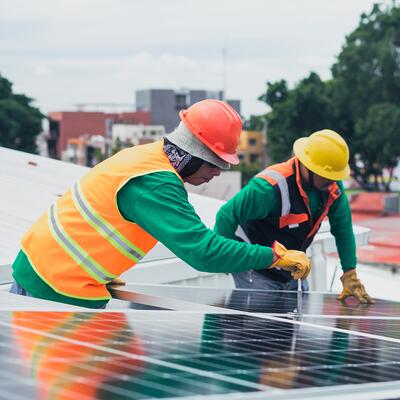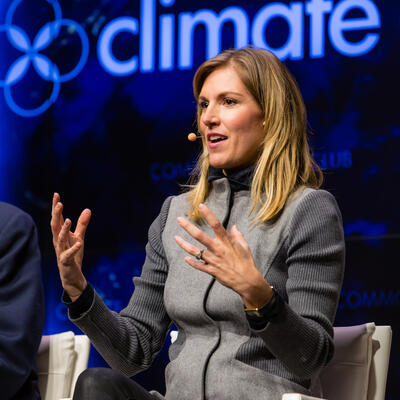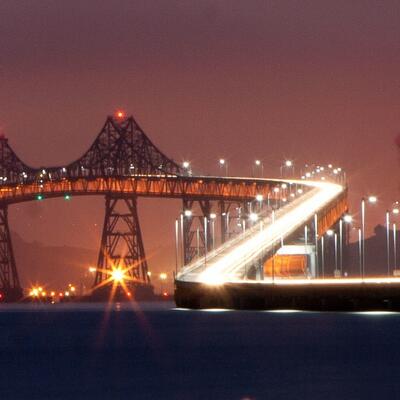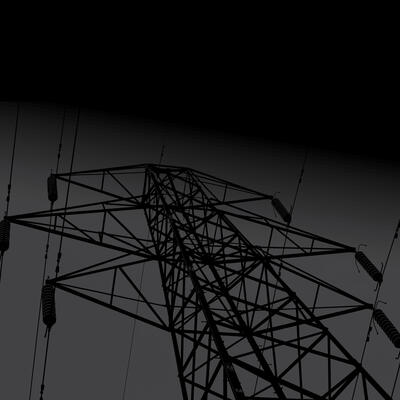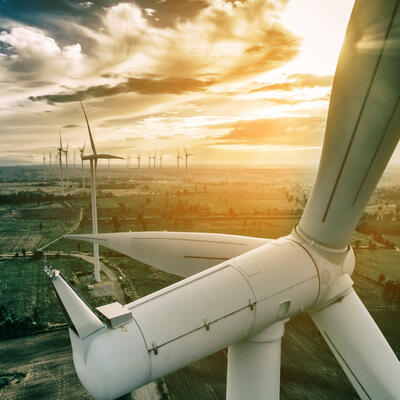
Superpower: How Renewables are Transforming America's Energy Future
Guests

Lynn Doan
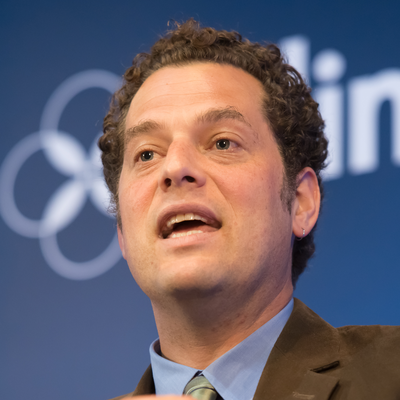
Russell Gold
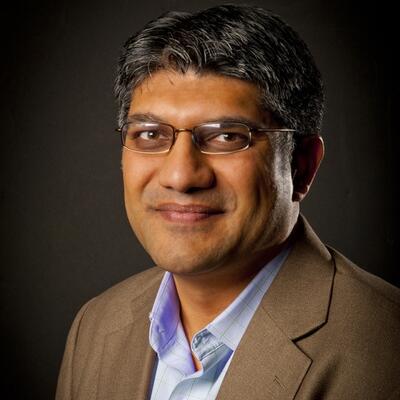
Jigar Shah
Summary
What’s new in renewable energy?
In April, 23 percent of America’s electricity came from renewables, surpassing coal for the first time. Ten states, and Puerto Rico and Washington DC, have policies in place to run on 100 percent clean power in coming decades.
Achieving that presents a host of challenges, from updating an aging electricity grid to financing energy innovation to figuring out how to transport and store the renewable power. Fortunately, says author Russell Gold, we have the talent to take those challenges on.
“There's a lot of creativity in the space right now,” says Gold. “There's creativity on reducing demand, there's creativity in how we aggregate solar… and frankly, given what's going on with the climate, we sort of need to be trying them all -- simultaneously.”
And if we succeed, we stand to gain a lot more than just cleaner air, a stable planet and lower electricity bills. We also open the door to a wealth of employment opportunities. Bloomberg’s Lynn Doan says this is the perfect time to diversify a sector that has been traditionally dominated by white males – what she calls the industry’s “dirty little secret.”
“The renewable energy industry is creating more jobs than any other industry in the United States,” says Doan. “The solar technician and wind technician jobs -- those are the two fastest-growing professions in the U.S. today. So if women and minorities are missing out on this renewable energy industry opportunity, then they’re being left out of the biggest job boom that America has to offer today.”
Something else to look forward to? The end of the gas-guzzler. Jigar Shah, co-host of The Energy Gang podcast, says drivers won’t miss having to stop to fill up their tank. “It’s not like an enjoyable experience; it’s a necessary evil for what they need for mobility,” he tells the audience. “And I think people are starting to realize now that with these 200-plus mile range electric vehicles, you really can go across the country.”
This program was recorded in front of a live audience at The Commonwealth Club of California in San Francisco on August 5, 2019.
Resources From This Episode (3)
Full Transcript
Greg Dalton: This is Climate One, changing the conversation about energy, the economy, and the environment.
On today’s program - what’s new in renewable energy?
Russell Gold: There's a lot of creativity in the space right now. There's creativity on reducing demand, there's creativity in how we aggregate solar… and frankly, given what's going on with the climate we sort of need to be trying them all simultaneously.
Greg Dalton: America faces a lot of challenges in transitioning from fossil fuels to renewables. But we stand to gain a lot more than just cleaner air, a stable planet and lower electricity bills.
Lynn Doan: The renewable energy industry is creating more jobs than any other industry in the United States. The solar technician and wind technician jobs those are the two fastest-growing professions in the U.S. today.
Jigar Shah: When you talk to people they don't want to go to gas stations to fill up their tank. It’s not like an enjoyable experience; it’s a necessary evil for what they need for mobility.
Greg Dalton: Superpower: how renewables are transforming America’s energy future. Up next on Climate One.
Greg Dalton: What’s next in the transition from fossil fuels to renewables?
Climate One conversations feature oil companies and environmentalists, Republicans and Democrats, the exciting and the scary aspects of the climate challenge. I’m Greg Dalton.
In April 23 percent of America’s electricity came from renewables, surpassing coal for the first time. Ten states, and Puerto Rico and Washington DC, have policies in place to run on 100 percent clean power in coming decades. Achieving that will require updating an aging electricity grid, financing energy innovation and figuring out how to transport and store the renewable power. The good news? There’s a lot to be excited about.
Jigar Shah: I’m super excited about geothermal heat pumps and air source heat pumps. Because I think that air-conditioning to me is the big challenge as we make sure that people are comfortable through climate change around the world.
Lynn Doan: I think batteries are something that people should definitely be paying attention to. The lithium-ion boom is something to watch.
Russell Gold: Offshore wind is completely taking off; on the east coast of the United States we’ll have probably 3 or 4 gigawatts. So think about that it’s like two medium size nuclear power plants within the next few years.
Greg Dalton: On today’s program, we’ll hear the story of one entrepreneur who tried to sell renewable energy at a bargain price to one of the country’s biggest power buyers. We’ll also learn about clean energy’s dirty secret. My guests are Lynn Doan, team lead for Power and Gas at Bloomberg News, Jigar Shah, founder of SunEdison and co-host of “The Energy Gang” podcast, and Russell Gold, Wall Street Journal reporter and author of “Superpower: One Man’s Quest to Transform American Energy.” To talk about where we’re going, we have to first know where we started. Russell Gold sets the stage.
Russell Gold: Well, when we started building the power grid and this is going back over hundred years. We would build these were very small grids, you know, you’d have a coal burning power plant and maybe would feed within a mile or two. But there was a big problem with that. We would use coal in these things we call them dynamos, and they be in a basement and base so your downtown would just be filled with smoke. So then someone said, well, we know let’s start moving the generating stations further away building transmission, building larger networks and so we started doing that.
And then about 1920, 1910, we started connecting these different regional grids because it was efficient, you know, we could build bigger plants and we could drive down prices and we had hydro in certain places we could share. So we started building slowly the beginnings of a national grid. The problem is we stopped. We didn't complete this journey. And so what we’re left with in this country are not one national grid or a continental grid, we have three grids but even within that we have sort of this weird balkanized system where we have different grids in each state or in each region. And the idea of generating let's say, for the sake of my book, wind in the Great Plains and moving that power towards California moving it towards the east coast is just inconceivable. We built up too many barriers and we don't have a grid that sort of thinks that way.
Greg Dalton: And we did that with highways as you note in your book. So tell us about Michael Skelly, character you focus on an entrepreneur energy executive who tried to build an electrical highway. So set that up for us and then we’ll hear a little bit from him.
Russell Gold: Sure. So when I set about to write this book. What I wanted to do is write a little bit about scale. You know, I wanted to write who's out there tackling trying to build renewables trying to really make a difference. And I encountered, a couple of people told me I need to meet this guy in Houston named Michael Skelly. So I went to meet him and it turned out he'd been building wind since about 2000 and he had this big idea. And the big idea was let's build in the middle of the country in the Oklahoma Panhandle in Kansas. Let's build these giant wind and potentially solar farms and then let’s build essentially long extension cords transmission lines, DC transmission lines to the east and to the west to bring that inexpensive power. And so he set off about 2009, he set off to do that.
Greg Dalton: And that's the story of your book. But after about a decade of work on the project, Skelly's dream collapsed. Here he is telling him just a bit of his story.
Michael Skelly: I got involved in wind in the late 90s, originally in Latin America and then quickly thereafter in the United States. You don't have to spend that much time in wind energy to realize that one of the biggest constraints of the future deployment of more wind is the lack of infrastructure.
The wind is concentrated in the United States in the middle of the country and the trick is to get it out of the middle of the country to major load centers. And we are focusing on the Chicago, Illinois area, Indiana and this is subject in the book focused on a big project from the Panhandle of Oklahoma to Memphis, where we could get power to TVA and to states throughout the Southeast. Trying to work with TVA was really quite frustrating because we feel like we proved out with numbers that we would save TVA ratepayers a lot of money and we could never get them around to that view. I think their view was colored by other considerations other than cost.
Renewables have become a bit more of a partisan issue and that's not really good for anybody particularly when the economics are now so clearly positive for renewable energy.
I got involved in wind energy in the late 90s because I thought it was just a very cool and interesting thing to generate power using the wind. And 20 years later I am super bullish on the prospects for wind energy. I continued to be concerned that we’re not building the right infrastructure to go with these new forms of energy. So that's my note of caution.
Greg Dalton: That's Michael Skelly, the founder and chairman of Clean Line Energy Partners. Russell Gold, a couple things that I wanna pick up. One is price, price doesn't win. We’re taught that in markets, low-cost wins and in this case, low-cost didn’t win.
Russell Gold: Right. Well, I mean one of the remarkable things about renewable energy these days is that on a pure generational perspective it is now the low-cost source of electricity. Five years ago couldn't say that at all, now it's true. You know, Skelly and his team at Clean Line they were offering TVA a 20-year contract at this incredibly low price of $18.50 per megawatt hour. So you don’t need to know all the details and the economics that is a remarkably low price. And yet TVA wasn't taking it. And the lesson here and I get into this in the book was that sometimes markets don't win out sometimes politics wins out.
Greg Dalton: So what’s the upshot you wrote this book about this guy who has this grand vision to bring affordable clean energy and kind of the empire eats him up, he doesn't win.
Russell Gold: Yes and no. So, I focused on one particular line he was trying to build from Oklahoma to Memphis. But he had about three or four lines he was working on. One of them looks like it actually is gonna get built. He had to sell it off to a Chicago company called Invenergy that looks like it’s gonna be built. So we still have the possibility of one of these lines getting built and showing what, you know, how much it could be -- that how much savings could be generated, how much money you can make as an investor. And that’s important because if we’re gonna have an energy transition there's got to be private capital. Investors have to feel like they're gonna get a good return and that's one of the things he was really trying to show.
Greg Dalton: Jigar Shah. You’ve been involved in solar, one of the other big renewables for a long time for many Americans who are around then solar they think of panels on the White House, right. Jimmy Carter putting panels on the White House. So tell us the history of renewables and solar since Jimmy Carter did that. We know Ronald Reagan took them down but summarize the arc of the story the last couple of decades.
Jigar Shah: Well, those solar panels were solar hot water panels they weren’t even solar photovoltaic panels. Yeah, I started my journey in ‘95 for AstroPower. And the solar panels that we sold there were for telecom towers and ranchers, right. The telecom towers were, you know, they were helicoptering diesel to these telecom towers. And so solar was way cheaper than helicoptering diesel to telecom towers, right. So that was our big market in ‘95 and then, you know, you had ranchers who wanted to electrify fences and five-watt panels along their fence were a lot cheaper than connecting to the grid on their fence, right.
And so, you know, fast forward to 2003 I started SunEdison and we won the largest contract ever in 2004, which was the California Power Authority give us a 4.3 megawatt contract on 13 buildings across California, right, Chuckawalla State Prison and California State University locations, etc. And we closed big financing with Goldman Sachs it was the first institutional capital that was raised for solar. And that model that we created has now attracted close to about a trillion dollars of capital. So we’ve come a long ways today and I would say today the thing that people I think have a hard time wrapping our brain around is how much money has been made in this sector, right. None of that trillion dollars lost money. All of it has made tons of money, right.
Greg Dalton: But SunEdison went bankrupt.
Jigar Shah: Well, I sold the company in 2009 and made a lot of money on that sale. And the person who bought the company from me, yes, like put them to the ground. But I think that --
Greg Dalton: Well, there’s winners and losers here, okay.
Jigar Shah: Well, but the trillion dollars is what matters, right. The 50 million here and the 100 million there that's put into companies is what everyone loves to lionize and talk about how wonderful these people are. But the trillion is all pension money, sovereign wealth fund money that's going into ownership of these solar plants, ownership of these windfarms. And that money is actually making really good 7, 8, 9, 10% returns on investment which is helping to pay pensioners over 20 to 30 years and lot of insurance company money is in there, etc., right. So I think that it's important to know just the sheer size of the capital because people talk a lot about $200 billion going into fracking or all these other things. But the numbers that we’re putting up rival those numbers and actually beat them on a regular basis.
Greg Dalton: And this is real institutional sort of core big smart money so to speak.
Jigar Shah: Big infrastructure, big Australian superannuation funds, Swiss funds Canadian pension funds.
Greg Dalton: Lynn Doan, the clean energy sector has a dirty secret. What is the dirty secret of clean energy?
Lynn Doan: The dirty secret is that renewable energy actually looks a whole lot like the rest of the energy industry, white, male and aging. Last year it’s funny because we wrote this great feature about the fact that renewable energy was helping the power sector really break the mold. They were hiring these women for really important leadership roles and a lot of that had to do with the fact that it's an industry of change, right, so utilities are in a very transformative period and that's opening up this opportunity for women to rise through the ranks in a way that they hadn’t been able to before. Well then this Brookings Institute Report comes out earlier this year and it shows that renewable energy generation is actually just like coal and natural gas and oil. And in some ways it's actually less diverse than those fossil fuels industries and we set out to find out why.
So we wrote a big story earlier this year about the fact that renewable energy is essentially an engineering and construction industry. I mean if you think about it, it’s just building these massive solar and wind projects. And we all know that the engineering and construction industry has basically been a male-dominated field for many, many years. But that’s not where the story ends because the reason why we actually wrote this story is because we were then hearing from women at these solar and wind projects that were saying where the heck are all the other women here and what they know that a lot of the other people might not know is that the renewable energy industry is creating more jobs than any other industry in the United States. The solar technician and wind technician jobs those are the two fastest-growing professions in the U.S. today. So if women and minorities are missing out on this renewable energy industry opportunity then they’re being left out of the biggest job boom that America has to offer today and that's why people are calling for change.
Greg Dalton: And like 10 years ago Van Jones is out there with green collar jobs, which was supposed to be part of the promise of green energy is labor jobs that could not be exported to China, installation jobs. So why hasn’t that happened?
Lynn Doan: I think that, you know, from the interviews that we did as part of this story. What the industry is coming to realize is that they have fallen into what somewhere calling a startup phenomenon. You have this industry and it’s nascent and all their focused on is growth and getting their product to market and making it happen. And they couldn't afford both financially and just resource wise the attention to be focused on things like how do we get more women into our workforce. How do we get more minorities? And as Jigar can testify to it’s a realization that the industry is now coming upon now that it has established itself as a major part of the U.S. economy and is now saying okay this is a problem let's clean it up now.
Greg Dalton: Jigar, what are the structural factors that kind of favor wealthy white men to lead in clean energy. You say there’s some really some structural reasons.
Jigar Shah: Well, as a wealthy white man--
[Laughter]
-- I could answer that question. Look, you know, I think in the early days when I joined the industry, if you were a developer, right, you basically worked for free. That's how you became a developer you paid with sweat equity to get into the business. You may have gotten a few dollars from this person and that person to pay for couple of interconnection studies or whatnot but ultimately you worked for free. And obviously people who work for free are --
Greg Dalton: Work for free hoping for a big payout.
Jigar Shah: Yeah, equity, sorry, like those people are generally folks who can afford to do that, right. So they come from some sort of capital source that allows them to be able to do that, right. So and then the same thing was true with solar installers I mean for solar installers, you really needed a $200,000 credit line to be a solar installer, right. And so that credit line had to come from somewhere and the vast majority of those credit lines came from people's home equity in their homes, right. So if you didn't have that home equity --
Greg Dalton: And that's what you did.
Jigar Shah: I did the same thing to start SunEdison. So if you didn’t have that home equity because you are redlined in 1950s or whatever it is that caused you not to have that then you can imagine that no matter how much passion you have for that industry it was really hard for you to set up that business. And so I do think that is how we came about and how we started but, you know, I think today there is a tremendous amount of focus on solving that problem. Whether it's grid alternatives here in California which has branches across the country or whether it's many other organizations. I do think the renewable energy industry is taking seriously its responsibility to help change that trajectory.
Greg Dalton: You’re listening to a Climate One conversation about America’s renewable energy future. Coming up, will a fractured society hold us back?
Russell Gold: One of the barriers that prevents us from thinking big is a division right now in this country between people who feel like they’re being left behind and people who are benefiting from this incredibly long economic expansion we’re going through. And that's a problem. Until we solve that it's gonna be really hard to think about big energy projects. [:16]
Greg Dalton: That’s up next, when Climate One continues.
Greg Dalton: This is Climate One. I’m Greg Dalton, and we’re talking about transforming America’s energy future. My guests are Russell Gold of the Wall Street Journal, Lynn Doan of Bloomberg News and Jigar Shah, co-host of The Energy Gang podcast.
America has always been known for its big ideas – from the railroads to the interstate highways to the moon landing. But when it comes to remaking our national energy system, can we pull it off? Can America still go big? Here’s Russell Gold.
Russell Gold: Well, I think we better. If we can’t I think as a country we’re gonna be in big trouble. But one of the lessons from my book was just how difficult this became. When Skelly and the Clean Line group were trying to build this transmission line, they were going into places like Arkansas to try to get not just political permission but permission from the landowners and was encountering this resistance. And one of the fascinating things I wanted to know is where is this resistance coming from. Yeah, they were offering payments, you know, this is much like leasing for oil and gas. And a lot of the opposition was coming from people who were just sort of saying you know what I haven't benefited from the last 10 years of the economic boom. The economic boom post great recession has helped the coasts and has helped you, private company out of Houston. I didn't feel anything. And now you want to come in, and you want to take my land to build the transmission line. So the point I think I'm trying to make is that one of the barriers that prevents us from thinking big is a division right now in this country between people who feel like they’re being left behind and people who are benefiting from this incredibly long economic expansion we’re going through and that's a problem. Until we solve that it's gonna be really hard to think about big energy projects.
Greg Dalton: And Jigar Shah, the Green New Deal one of the things that brought together was saying, we need to address climate change but there's some fundamentals of capitalism and wealth and power distribution that need to be solved at the same time. Your thought on that.
Jigar Shah: Well, it certainly polls well. So that's good. Look, I do think that we have to acknowledge what it is that we all enjoy, right. Whether it's being able to jump into a car and drive four hours to the nearest like tourist attraction for vacation with your family or whether it's figuring out how to get electricity, water, sewer, natural gas connections to your home, right. Even today almost 40% of Americans are not connected to natural gas, right. So as much as everyone's like natural gas for all we frack the, you know, we’ve got solution to fracking and we basically got cheap gas. There’s a lot of people on propane there's a lot of people on electricity there's a lot of people on fuel oil, right. And so I think one of the challenges that I see is that we just tend not to finish our work, right. In the 1980s we had built all of these nuclear plants in the 70s and so we were actually full of electricity. With so much electricity we had no place to put it, right.
Greg Dalton: Too cheap to meter.
Jigar Shah: Right. And so we built pump hydro, not because we thought we needed storage on the grid, but because we had no place to put the nuclear power because it had to run 24/7, right. We also converted all of the water heaters in Washington state or in like Florida to electric. Think about how that happened, right, the utility company woke up one morning and said, we are rate basing all of this, right. You get a water heater and you get a water heater and you get a water heater, right. And everyone got a water heater and they sold more electricity. Today, right, if you’re in Vermont or New Hampshire or New York these are the places and you have people on fuel oil. They have health impacts that are higher because they burn fuel oil like the utility company feels powerless to go to them and say we're going to give you an air source heat pump we're going to give you a ground source heat pump and we’re gonna rate base it, right. Instead, they say here's a $2,000 subsidy and then if you can fill out this paperwork and you can figure out this third-party ownership structure then maybe we’ll convert you, right.
I think part of the Green New Deal I hope and right now it's a resolution so you can see whatever you want to see in there, right. But part of it I think I hope is to suggest that the government does have a role in saying this stuff has been fully tested, right. We already know how to do this. When you think about the polar vortex, there are people in my hometown in Sterling, Illinois that couldn't get their homes above 55° because it was just so leaky and they just couldn't do it, right. We know how to weatherize homes. In fact, we increased weatherization dollars 10X during the stimulus bill the American Reinvestment Act. So we just have didn't finish the job, right. And so I hope that the Green New Deal means that, you know, there's a way to finish what we started
Greg Dalton: California wants to move away from natural gas. And so the idea that everyone is not connected to gas California is trying to make it so there’s some people never connected to natural gas and electrify everything but Russell Gold, you want to jump in?
Russell Gold: You are saying before and I thought was interesting that we built pump storage because we had too much generation. We’re entering a phase in this country where we have too much generation to certain things. In Texas there was too much wind that was being built so what did Texas do, did something very un-Texas and I can say this as a Texan, they socialized the cost of billing transmissions. So we got all these great new transmission lines and now Texas has 20% first six months this year, 20% of the Texas grid ran off wind.
Jigar Shah: More than they used coal.
Russell Gold: Yes, exactly. And so you, you know, one of the things that might be happening here in the United States is that because we have the potential for so much inexpensive wind and solar as that gets built out there's going to be an increased pressure say what do we do with all of these. And one of the answer is gonna be, hey, let’s build some wires. Let’s build some wires to get this to different people. And that’s going to be a potential, you know, that's where there's gonna be jobs there. This is sort of what we do in the United States it’s something Skelly said a lot. We overbuild and then we realized we got a problem and then we go to solve it. So maybe that's how we, getting back to your question for me, maybe that’s how we do big things. We sort of back ourselves into a corner and then say, oh, what do we gonna do we built all these, you know, these wind farms in the middle of the country what do we gonna do with them. You know, here in California we’re putting up all the solar and then there are certain times of a day where power we don't even know what to do with all the power we’re generating too much of it. So maybe the answer is we start doing big things when we back ourselves in the corner and then we got to figure out a solution.
Greg Dalton: Lynn Doan. There’s some interesting innovation happening where the combination of batteries and renewables replacing gas-fired power plants. There’s one in Glendale Southern California near Los Angeles where batteries are distributed. Solar and geothermal are replacing gas-fired plant here. In the Bay Area Oakland, California a power plant that runs on jet fuel, super dirty, is being replaced by sun-run solar and battery. So talk about these virtual power plants and how storage is kind of that really starting to knock out some of the dirty fuel.
Lynn Doan: Yeah, you know, Jigar and Russell are gonna kill me because they just talked about how powerful politics play into this in the renewable energy boom. What I would say is renewable energy is happening despite politics as well, right. I mean you have an unprecedented tax on solar imports and solar is still getting installed both on the roof top level and in a big way. And it's the same thing with solar and batteries what you’re talking about are these virtual power plants and really what they are just these clusters of batteries and solar and wind. I mean they are like clusters of wind, solar and battery altogether being proposed as these massive power plants across the United States and it's not like they are being propped up by policy. There are some that are just competing in regular I can't say RFP because you won’t allow me, request for proposals from utilities that are saying we just need power who's going to bid for this power and they're beating out natural gas they're beating out coal, they’re beating out other very traditional forms of power. So I’d argue that there’s a place for renewable energy and for development of that regardless of policy but that is what you're seeing in these places where traditional power plants are being phased out and instead of being replaced with other power plants they’re being replaced with solar and wind and batteries.
And, you know, the one point that I wanted to make about virtual power plants is when you brought up that phrase that's not actually the first definition that comes to mind when I think of a virtual power plant. The first time I heard that phrase it didn’t relate to replacing power generation with more power generation. It referred to power demand from people like you and me. So there were these tech companies that are going out there and saying, hey, if we can aggregate all of our power demand and we could like commit to reducing it by this much at this time and then sell that commitment as a commodity into the wholesale power markets, we could make money we could kill the need for more power plants in the future. And I think that that’s like a really interesting idea that we shouldn't lose sight of because while energy efficiency and like energy demand are the sexiest of topics in our world, they actually have contributed to emissions reductions in a way that other energy resources haven't been able to do.
Russell Gold: You know, it's a great point because there's a lot of creativity in the space right now. There's creativity on reducing demand there's creativity in how we aggregate solar. Look, I wrote a book about transmission I actually don't think transmission is the silver bullet. It is one of these different ideas and frankly, given what's going on with the climate we sort of need to be trying them all simultaneously. We don't have the luxury say, you know what let's build transmission and see if that solves the problem. Let's do a lot of distributed solar and see if that solves the problem. We sort of need to be doing it all at the same time for a couple of different reasons. One, some parts of the country work better with solutions than others. We need to be moving quickly and look, I'm not smart enough, Jigar maybe you're smart enough, but I’m not smart enough to tell you I know what the answer is. How we’re gonna be powering the United States or the world 20 or 30 years from now. But I am certain that that idea is out there right now and given the right amount of capital and the ability to go out, you know, something is gonna catch fire. I wrote several years ago I wrote a book about fracking and now we talk about fracking we understand just how it's, we’re producing so much more oil, natural gas in this country. Twenty years ago when the first modern well was fracked, the engineer, who I’ve talked to several times had no idea that this was going to be such a big deal. Sometimes it takes that small idea let’s experiment let’s see if this works and it sort of just catches fire and grows.
Jigar Shah: Well, just to put some numbers around it. I think in the state of California but this is true nationwide. If you had a million high-capacity electric vehicles, vehicles that have over 200 miles of range. That alone basically in a vehicle to grid format could back up the whole California power grid, right. If you had 4 million houses that had a Next thermostat or Ecobee could do the same thing, right. California is mandating solar on all new homes starting next year. They build about 200,000 new homes per year. If you have 10 kW per home because they’re no longer gonna be connected to natural gas and they’re powering all of it. Then you're talking about 2,000 megawatts getting added every year, right. Just from that which is massive right. And so I just think that when Russell and Lynn talk about how this all come together, you really can see how you get to scale through 5,6, 7 ideas very quickly like in less than 10 years.
Greg Dalton: One of the things that are happening think a lot about power these days. The industry of Thomas Edison and the industry of John D. Rockefeller are colliding and kind of getting in each other's lanes, right. So the electricity companies are getting into transportation, transportation oil companies are getting to electricity. So Jigar, talk a little bit about the industries of Edison and Rockefeller colliding over this new transition.
Jigar Shah: So one of my first jobs was working for BP. I still remember all the people I worked with I mean just the smartest people you'd ever work with in your career. And so organization that had deep amount of training and all the technical know-how I mean going into places like Azerbaijan or Angola or Russia and like figuring out how to like make that work is, you know, extraordinary. So I learned a ton --
Greg Dalton: Suitcases of cash that’s part of it.
Jigar Shah: Yeah, there were definitely exchanges of monetary equivalents. I think as we call it. But I think what's amazing today is they are more afraid of electric vehicles than they are of anything else. And the main reason for that is I remember in 2004, I think it was 2004, we had a Honda Civic hybrid. And I dont’ know if you remember but Washington DC had that sniper that was killing people while they were filling up their gas tank. My wife was so ecstatic that we had 700 miles of range that we never had to fill up our gas tank that entire time. And when you talk to people they don't want to go to gas stations to fill up their tank. It’s not like an enjoyable experience it’s a necessary evil for what they need for mobility. And I think people are starting to realize now that with these 200 plus mile range electric vehicles, you really can go across the country. I mean one of my high school friends who you wouldn't have thought, you know, was gonna do this, got one of the first Model Xs, right, it was a $100,000 vehicle he wasn't making that much money he was a senior engineer on the OnStar program. And you know, he came out to visit me and drove from Chicago to DC in his Model X and he said it was a very pleasant experience. He had like one Tesla super charge, kids loved the half an hour break and it was easy to do. And so they are really reeling because what you find is the automobile sector even though they’ve been joined at the hip with the oil companies they don't want to be. They really are consumer companies, right, they actually want to be responsive to their consumers and they’re realizing, wait a second, why are we so tied to oil. We don't have to be we can be just as innovative and just as successful on the electric vehicle side and they’re starting to break those ties. And the oil companies beside themselves trying to figure out what to do next.
Greg Dalton: This is Climate One. You're listening to a conversation about trading in fossil fuels for a clean energy future. Coming up - one idea for giving new life to an outmoded industry.
Lynn Doan: There's a developer that has made a business out of buying old coal plants, tearing them down and making them into waterfront experiences for hipsters like in places like Boston. So they at least have an afterlife. [:11]
Greg Dalton: That’s up next, when Climate One continues.
Greg Dalton:This is Climate One. I’m Greg Dalton. We’re talking about America’s energy future with Jigar Shah of The Energy Gang podcast, Russell Gold of the Wall Street Journal, and Lynn Doan of Bloomberg News.
After over a century of energy domination, king coal is in decline. The last ten years have seen a drop in production, and recently, coal plants have closed in Colorado, Wyoming, Kentucky and Virginia. Is the promised revival of coal happening?
Lynn Doan: It's still on a decline; I think the U.S. government has estimated that more than 550 coal-fired power plants have retired since 2010 now. And I think something like 4 gigawatts is scheduled to retire in this year alone. So there's that and it's not really due to politics or policy it's really just market forces. Natural gas remains cheap, solar and wind are getting cheaper; batteries are helping with that. And if it's any testament to where coal is headed we just had this great feature like a week ago about the fact that there's a developer that has made a business out of buying old coal plants, tearing them down and making them into waterfront experiences for hipsters like in places like Boston. So they at least have an afterlife.
Russell Gold: I’m amazed that on energy Twitter which we’re all involved in. There’s somebody who will remind us every day that the British or I guess it’s the English grid is not on coal. So I mean here's a country which the industrial revolution basically pioneered the use of coal for any number of things including pre-power generation for industrial purposes has been going relatively long stretches of time a week or two without using any coal. We’re not there at the United States yet but it's not inconceivable to think that we’re only what may be 10 years away.
Greg Dalton: But Jigar Shah, in 2018 global coal emissions rose.
Jigar Shah: They did. It’s a stubborn problem. I think in China where people accuse folks of, you know, getting it wrong their coal still peaked in 2013. So they haven't gotten back to 2013 levels yet but they have gone up the last two years. Look, I think, you know, people have to recognize that this is really about an economics problem, right. The globe works on U.S. dollars for energy and if you're a country that doesn't have U.S. dollars and you have yuan or you have rupees and you have local resources there can be an economic incentive not to use your hard currency for importing other energy sources, including wind and solar and instead burning what you have locally, right. And I do think that that dynamic around the lack of hard currency for a lot of these developing countries really causes them to continue to burn coal. And we as a developed, you know, sort of OECD have to come up with solutions for that otherwise it’s gonna be difficult for them to move away from those resources.
Russell Gold: There’s another aspect that’s going on here which is that fossil fuels have I guess insinuated themselves so deeply into the economy that sometimes market forces aren't enough. So in India for instance, coal generation the movement of coal on the railroads basically subsidizes the railroad. So if you were to take coal completely out of the Indian economy, you’d have to figure out a new way to pay for the railroads, which would be a huge problem. So there are a lot of examples like this where fossil fuels have become so integral to other aspects of life that it's difficult to take it out. And even if you have a better replacement, wind or solar, you have to solve for problems you didn't realize you had.
Greg Dalton: Right. And Jigar Shah, there's huge global subsidies for fossil fuels. I forget what the number there is a report I remember I heard on The Energy Gang.
Jigar Shah: Pick a large number and that exceeds it probably.
Greg Dalton: Yeah, like trillions of dollars. And so many of these countries around the world, prop up the prices of fossil fuels, I mean keep them low to keep people happy, stay in power. What's the path forward for India getting off coal?
Jigar Shah: Look, I think India is more on track to get off coal than other countries because their coal is so terrible, right. And so their coal is some of the lowest heat rate coal that you can get. And so they're just burning dirt basically. So they are importing coal from Mozambique, Indonesia, Australia with the Adani you know, like mine that will never get built I think. And so India is trying its best to figure out how to get off its own coal just because it really doesn't make a lot of sense whereas China has very, you know, high quality coal.
But I do think that writ large, you know people in other countries are viewing this as a huge way of, you know, expanding wealth creation for their own countries, right. These are fundamental ways that they can employ their young people all of whom are desperately looking for jobs, right. And so you're in a place where I do think that we’re making great progress, particularly in places like Brazil or India or South Africa and other places because they see this as homegrown innovation. Most of these technologies are off of patent and so I do think that we’re on track to, you know, reaching our goals in those places.
Greg Dalton: Lynn Doan, what are some areas where there’s really good news or this exciting either technology process or sunshine in the renewable energy space that people may not know as much about. What are some real bright news?
Lynn Doan: I think batteries are something that people should definitely be paying attention to. The lithium-ion boom is something to watch it's completely transforming the renewable energy space in cleantech. And Bloomberg NEF just came out with an energy outlook earlier this year that said that something like two thirds of the world, in two thirds of the world solar and wind are now the cheapest form of new power and that compares to five years ago when it was less than 1%. And a lot of that has to do with the fact that batteries have helped unleash this and I think that they will continue to until something new comes about and transforms it yet again.
Greg Dalton: Batteries the disruptive happy storage. Jigar Shah, something exciting and new that you really think really excited about?
Jigar Shah: Well, I mean I’m super excited about geothermal heat pumps and air source heat pumps. Because I think that air-conditioning to me is the big challenge as we make sure that people are comfortable through climate change around the world, right. And I think that the technologies around geothermal heat pump are all decades old technology, but the newest form of them are so financially compelling that I think you're gonna see a tremendous shift towards those forms of, you know, climate control.
Greg Dalton: Right. And as it gets hotter people who'd never had air conditioning are starting to talk about getting it for the first time. Russell Gold, some optimistic bright spots you see out there?
Russell Gold: Offshore wind is clearly taking off on East Coast of the United States will have probably 3 or 4 gigawatts. So think about that it’s like two medium size nuclear power plants within the next few years. Taiwan, Korea, Japan, offshore wind and possibly off the Pacific Coast in California as well over the next few years I think there's gonna be a bid round in two or three years so we’ll sort of see how that goes. This is, it’s a huge change and the industry has figured out how to do it and actually interesting a number of the players getting into offshore wind are fossil fuel companies or former fossil fuel companies. They know how to operate in a billed platforms offshore. And you look at a company like Ørsted which used to be the Danish oil and natural gas company completely out of fossil fuels and is now making a very profitable business and building offshore wind.
Jigar Shah: Just to add to that. One of the reasons why offshore wind is taking off is because of transmission, right. Because you literally can just plug it into the urban center, and it's fairly easy to build transmission lines, you know, in the water off the coast.
Greg Dalton: You don’t have neighbors complaining about their views or ranchers saying don’t go across my land. Russell Gold, you’ve written some very impactful articles about Pacific Gas & Electric, the utility in northern California and had the rare experience of a judge requiring the company to respond paragraph by paragraph. So tell us what you wrote and what the impact was.
Russell Gold: Yeah, first of all if I could just say having a federal judge say that it sounds great unless you are the reporter who’s then has to wait three weeks to see, you know, what the response is which can be a little nerve-racking. So my colleague Katherine Blunt and I have been working a lot about this. The article that the judge that ticked off the federal judge was we reported some very basic facts which was that the PG&E has a number of hundred-year-old transmission lines and transmission towers and the hardware which are just sitting out there in parts of northern California that are incredibly fire prone right now and tender boxes. And PG&E's known about this they’ve talked about this internally in documents we turned up and yet they have not replaced it. And maybe 20 years ago that would've been fine, but these are parts of the country which are just incredibly susceptible to massive wildfires right now. Climate change has come in has dried out large areas you have the tree mortality problem of a few years ago so you just have large forest that are just ready to burn and people living either in or very close to those forests. It’s a huge problem and we've been writing about PG&E and its failure to adequately address this.
Greg Dalton: And is it the fact also that they’ve been steering money that could have been spent on clearing lines and shrubs and kind of putting into giving it to shareholders or executives?
Russell Gold: Well, if we could figure out exactly where the billions of dollars that they’re collecting exactly are going and we've tried we're trying. I could give you a very concise answer, but there's a lot of money going into PG&E right now and sometimes figuring out exactly what pocket it’s going into and what pocket it’s coming out to has been tough. So we’re looking at that.
Greg Dalton: There’s lot of municipal bonds issued by cities and school districts that also are not pricing in climate risk. We’re talking about climate change and clean energy with Lynn Doan, energy editor with Bloomberg News. Jigar Shah, energy investor and podcast house and Russell Gold, reporter with The Wall Street Journal and author of the new book Superpower: One Man's Quest to Transform American Energy. I'm Greg Dalton.
Male Participant: Well, thank you. Russell brought up a very interesting point that in addressing the barrier for having a transmission line, you also have to address division between people and that issue comes up often. Can capitalism actually address this? Why are we afraid of socialist planning? I said this as a personal experience I joined California Public Utilities Commission in 1978 and in 1988, I was talking about this fragmentation of energy in California is not really the answer we need to have central planning. And the answer to me was, Steve, central planning belongs to Soviet Union.
Greg Dalton: Alright. Thank you. Can capitalism solve this problem or is it part of the problem?
Russell Gold: Capitalism I think has to be part of the answer here. Because you mentioned before the Canadian pension funds. There is ton of money that wants to invest in renewable energy and if we’re going to make the kind of investments, make the kind of changes that are gonna be required we have to tap that capitalist, we have to use capitalism. But remember what I said before, Texas did this weird socialist thing where they spread the cost out to build infrastructure. So maybe a little bit of a balance. Some capitalism on one hand but some socialism on the other.
Greg Dalton: Well there’s many flavors of capitalism, Jigar.
Jigar Shah: Well, it’s really about the socialism aspect of it which I don't think is socialist at all. It's really just planning. I think that --
Well, like for instance, you know, the U.S. federal highway system prevents the use of any of the right of ways on the federal highway system for any commercial endeavor. Which is why you don't have any sort of McDonald's or whatever off the federal highways only off of like state highways, right. And, you know, the federal highway system already has the right of way. There’s a law change that could be made that just builds transmission lines across every federal highway system across the country and they have so much land on both sides that it wouldn't be a problem and it only costs about 40% more to bury it under the ground so you could bury it in the ground instead of having it up top. And, you know, so we could actually just get this thing solved, but it’s something that even the Obama administration one of the things that I like to point out is that, you know, during Mike Skelly's adventures right, Obama was in office the entire time. And he had the power of the 2005, 2007 Energy Policy Act to actually eminent domain all these power lines and didn't choose to use them because he didn't, you know, wanna ruffle feathers. So it’s one of those things where this is why the Green New Deal concept whether it's formed or not matters because government does have to lead in these planning exercises.
Greg Dalton: We could put some a high-speed rail along those roads while we’re doing those lines. Next question. Welcome.
Female Participant: Thanks panel. This is a lot like the previous question. And so where do we now find a legal construct understanding that climate change is a threat to our existence and our safety. So constructing a body that has standing that can say, you must do this or we’re threatened. Can we -- if capitalism isn’t gonna save us, can the courts save us? And by the way I'm a woman who’s looking for a job in energy.
Lynn Doan: I don’t know of the legal construct only has to relate to courts though. I mean Jigar and I were just talking about this California agency that's being established as part of legislators approval of a bill, gosh, was it just earlier this year it feels like this year has been forever because of PG&E. But, they passed this bill and this agency would be responsible for being essentially a backstop to California's renewable energy goals. So if utilities or community choice aggregators or anybody else who’s responsible for supplying power in California fall short of those goals this agency would be able to pick up where they left off and ensure that California still buys a certain amount of renewable energy to meet that. So, I mean I think that that's one example of what you're asking about this means of legal recourse if we’re not headed toward the direction that California wants us to be headed toward.
Jigar Shah: Yeah, I do think that there is some acknowledgment needed that the U.S. is not a top-down system. The U.S. is more like the E.U., right, to say that the U.S. needs to lead, right, is like saying the E.U. is leading and the E.U. is not leading, Poland is nowhere on climate change. And so it's really about, you know, Germany versus California or this versus that. And even there it’s really about, you know, mayors and towns right. We can't even have unified building codes or unified permit, you know, regions here in California.
So I think it’s important to notice that people really need to lead locally. And I do think the legal piece is really around state local policy, you know, like for instance, you know, I live in Bethesda, Maryland in Montgomery County, they have one thoroughfare that carries all the traffic basically to DC. And there's been a lot of talk about just banning personal car ownership on that thoroughfare, right, because you now have the abilities, Lyft Line, and UberPool and Via and this thing and that thing. And we already have that like so in the 1990s we called them slug lines, right, where people just would park at this parking lot and they would just wave somebody down and they were going down Rockville Pike. And so it’s not like this is a foreign concept to people but organizing the marketplace through city councils or county councils etc. is important I think.
Greg Dalton: You’ve been listening to Climate One. We’ve been talking about the future of renewable energy. My guests were Jigar Shah, co-founder of Generate Capital and co-host of The Energy Gang podcast, Lynn Doan, team leader, Power and Gas Americas for Bloomberg News, and Wall Street Journal reporter Russell Gold. His new book is Superpower: One Man's Quest to Transform American Energy.
Greg Dalton: To hear more Climate One conversations, subscribe to our podcast at our website: climateone.org, where you’ll also find photos, video clips and more. Please help us get people talking about climate by giving us a review wherever you get your podcasts.
Greg Dalton: Kelli Pennington directs our audience engagement. Tyler Reed is our producer. Sara-Katherine Coxon is the strategy and content manager. The audio engineers are Mark Kirchner, Justin Norton, and Arnav Gupta. Anny Celsi edited the program. Dr. Gloria Duffy is CEO of The Commonwealth Club of California, where our program originates. [pause] I’m Greg Dalton.
